Learn how to make Fermented Hot Sauce – a simple way to enhance and preserve your abundance of garden chilies to use throughout the winter. Full of healthy probiotics, this easy recipe has many health benefits. Plus it just tastes good! Video.
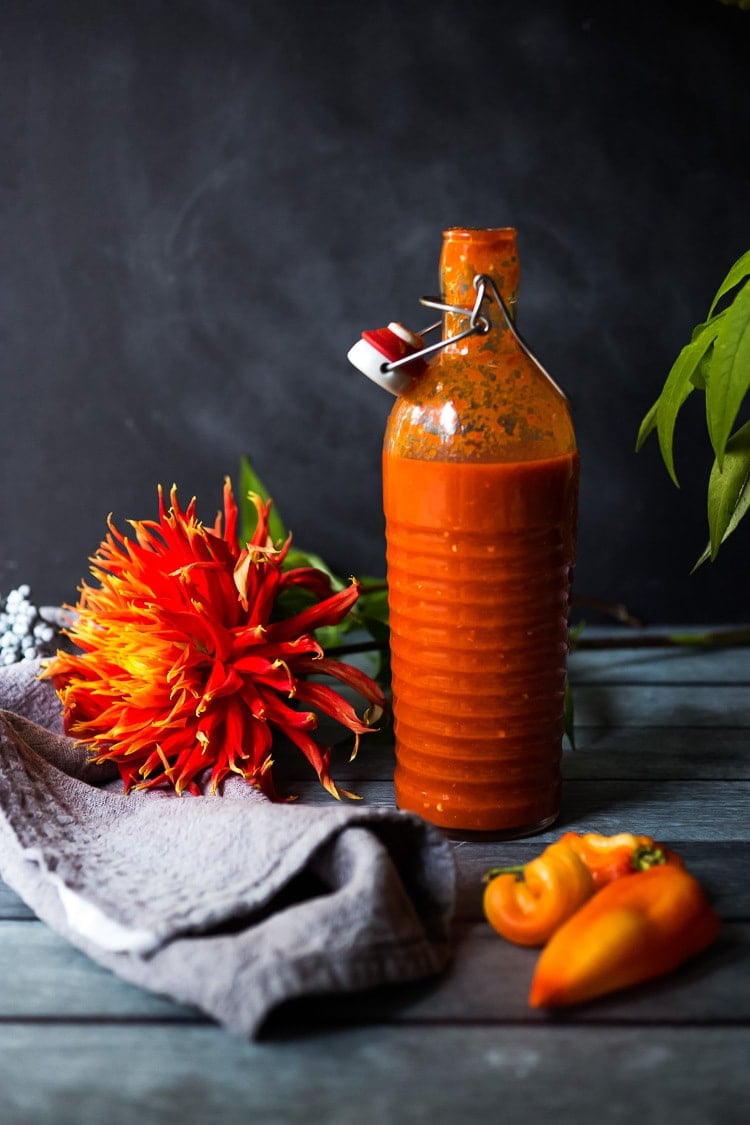
For many of you with gardens out there, this is the season of harvesting. Here’s a simple way to use all those chilies you’ve got growing out back and turn them into something that will bring you a little kiss of sunshine during the cold months – Fermented Hot Sauce! Now, before you feel intimidated – know that this only takes 20 minutes of actual hands-on time and no special equipment. It’s ridiculously easy!
Why I prefer fermenting over canning:
- Healthier: Fermentation creates “ALIVE” food- incredibly rich in probiotics. These good bacteria are living creatures that work with our microbiome to improve digestion, boost immunity, and prevent disease. Having a diverse microbiome is healthy! Canning “kills” all these healthy probiotics through the heating process.
- Taste: I prefer fermentation over “canning” because fermentation keeps these healthy bacteria alive, and as a result, the fermented food actually tastes better and better with time! Canning halts the development of flavor.
- It’s easier: Canning requires more hands-on time.
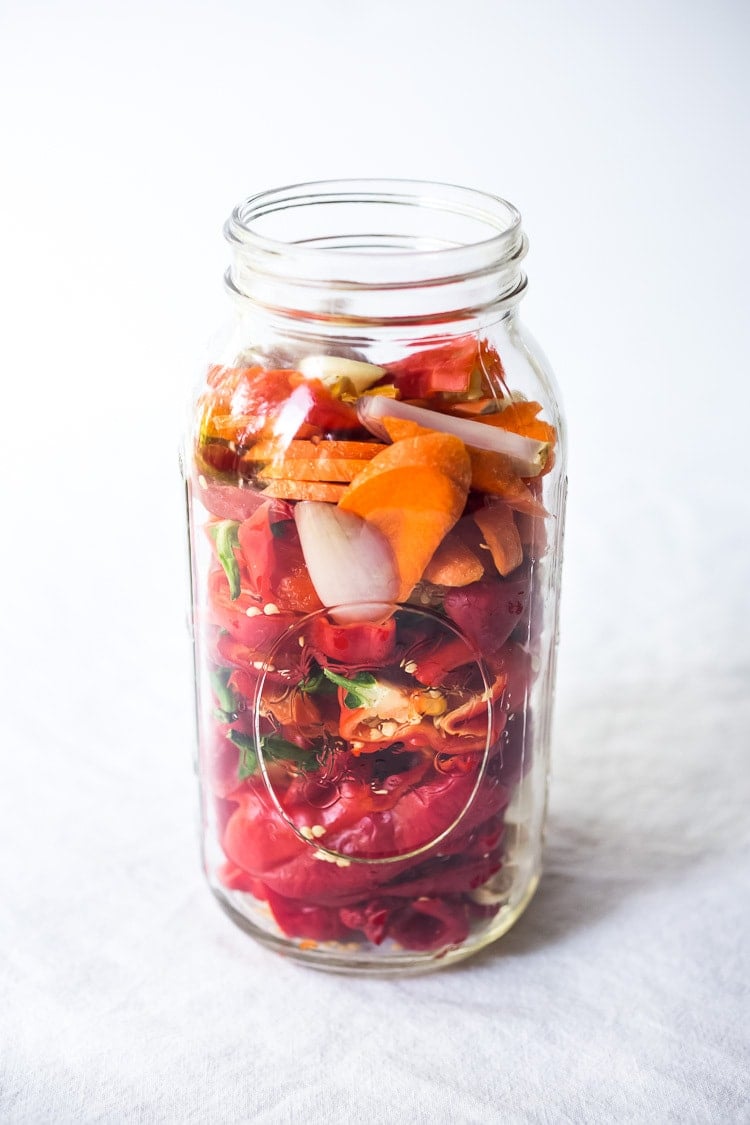
How to make Fermented Hot Sauce:
Step one: Fill a clean 2-quart jar with any type of fresh hot chili, onions, garlic and thinly sliced carrot. You can use bell peppers to temper the hot chilis if you want a milder version. Just stick with the same color palette so your fermented hot sauce stays colorful and vibrant.
In this recipe, I used Padrone Peppers, a Spanish variety that had turned red, which I found at our farmer’s market. But feel free to use any kind you want or a blend. You’ll need about 1 pound in total. (You can easily halve this recipe)
Step two: Make a saltwater brine, using 1 1/4 teaspoons fine sea salt, per 1cup of water.
Salt Ratio for Fermentation:
Having the right proportion of salt to water is important. Not enough salt may allow unhealthy bacteria to grow. Too much salt will kill all the bacteria and the chilies won’t ferment. If you need to add more water to the jar, then add salt accordingly.
Use 1 1/4 teaspoons fine sea salt per 1 cup of water. This is roughly a 3% Brine (3 grams of salt per 100g of water).
Here, I used 5 cups of water, so I added 1 1/4 teaspoon salt x 5 cups water = roughly 6 1/4 teaspoons of fine ground sea salt. Heating the water slightly helps the salt dissolve.
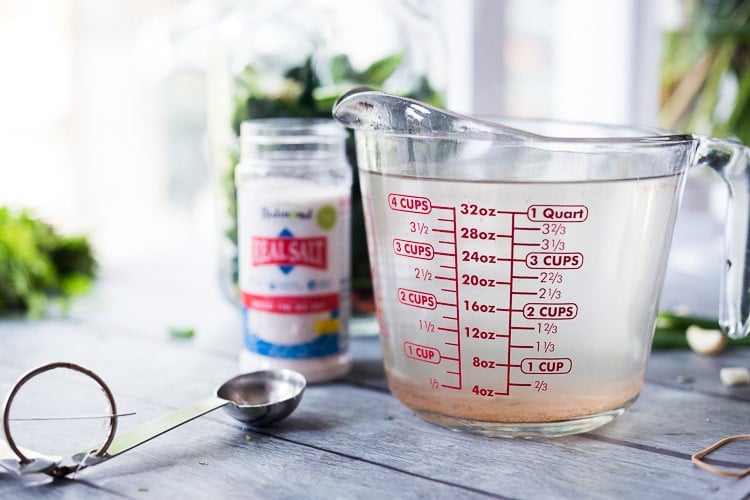
Step Three: Combine! Pour the brine over the chilies and push them down so they are completely submerged under the brine. Feel free to cover the chilies with a cabbage leaf to keep everything down, then weigh them down.
Step Four: Weigh down the chilies. You can use a fermentation weight, like this version that I really like, that will fit perfectly into a mason jar, to keep everything submerged. If anything floats to the top, and touches air, this can potentially mold, so either fish it out with a slotted spoon, or push it down under the brine.
Or in a pinch, a zip lock bag filled with water can be used as a weight, just place this over top. I prefer using a glass or ceramic weight.
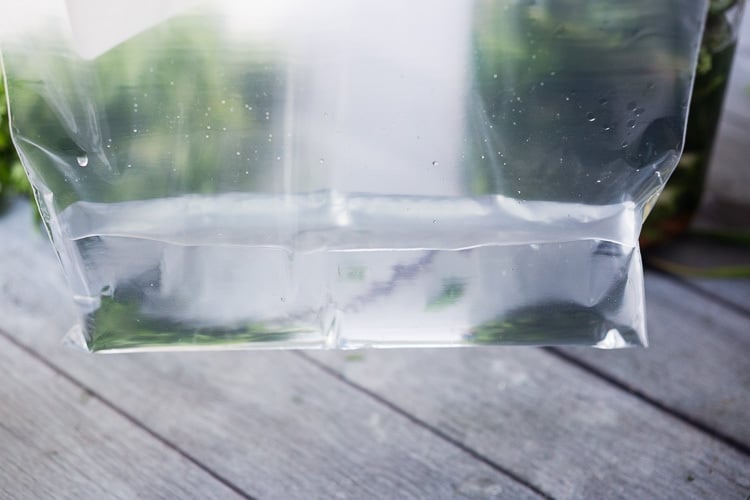
The water in the bag will work as the fermentation weight here. A small clean shot glass, placed over a cabbage leaf, can also act as a fermentation weight as well.
Here you can see I’m working on a mild green hot sauce which is in the fermenting phase still.
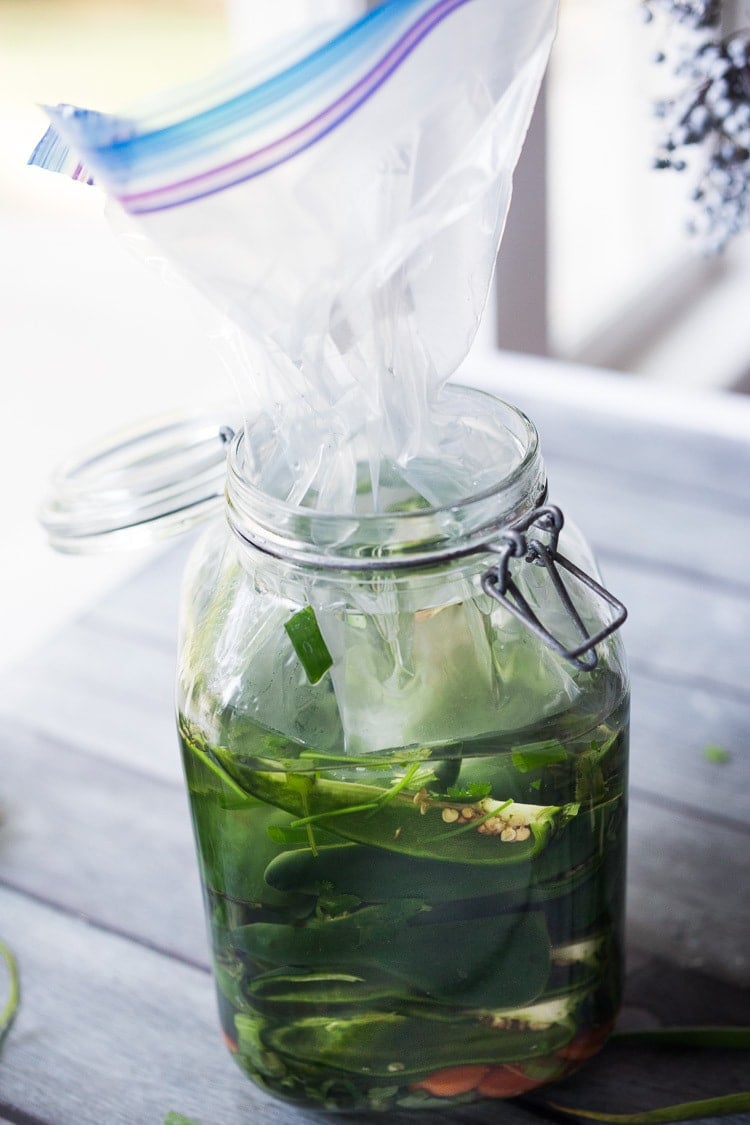
Step Five: Place a lid on top, leaving it loose. You want the fermentation gasses to be able to escape while keeping any creatures (bugs, flies) out. A couple of layers of cheesecloth also work here.
Step Six: Place the jar in a bowl or pan to catch any liquid that may spill over, and place it in a cool, dark place, like a basement. 65F-70F is ideal. If you don’t have a basement or a cool place, a lower cupboard in the kitchen is an option.
Check every few days, removing any “floaters”. After a few days, the brine will turn slightly cloudy, and when you tap the jar, you should see little bubbles float to the surface or some overflow on the pan- all signs of life!
Ferment 5-10 days. I usually go 7-12 days, long enough to soften those carrots, which you will be blending up in the sauce.
If, for some reason, you are going out of town, you can always place the ferment in your fridge, which will slow it down, but keep it alive, and you can resume when you get back.
Why is the Brine Cloudy?
Cloudy, tangy brine is a natural by-product of the fermentation process- a combination of lactic acid and yeast- and is the reason why they call it Lacto-fermentation.
Various strains of bacteria are present on the surface of all plants, especially ones growing close to the ground. Lactobacillus bacteria convert sugar into lactic acid, preserving the peppers.
Both salt and lactic acid prevent the growth of harmful bacteria. Over time, the cloudiness can settle out of the brine to the bottom of the jar. Some batches are naturally cloudier than others, but all are safe to consume.
A cloudy brine is a sign that you have a safe, successful, and tasty ferment.
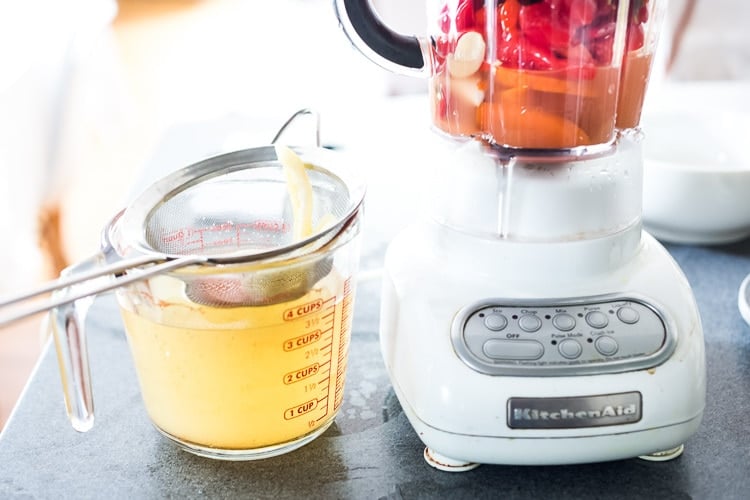
Step 7: Blend! Strain the brine, saving it. Add the strained chilies/carrots/garlic to the blender with one cup of brine and blend until smooth, a least a minute! At this point, you can add herbs (oregano or cilantro is nice here) and spices (cumin, coriander, chipotle). Add a little splash of Braggs apple cider vinegar if you like (this is optional but also full of healthy bacteria) and more brine to desired consistency.
If you like the idea Sriracha, you could also make it sweet by adding sugar or honey, and perhaps ginger. You could also add herbs.
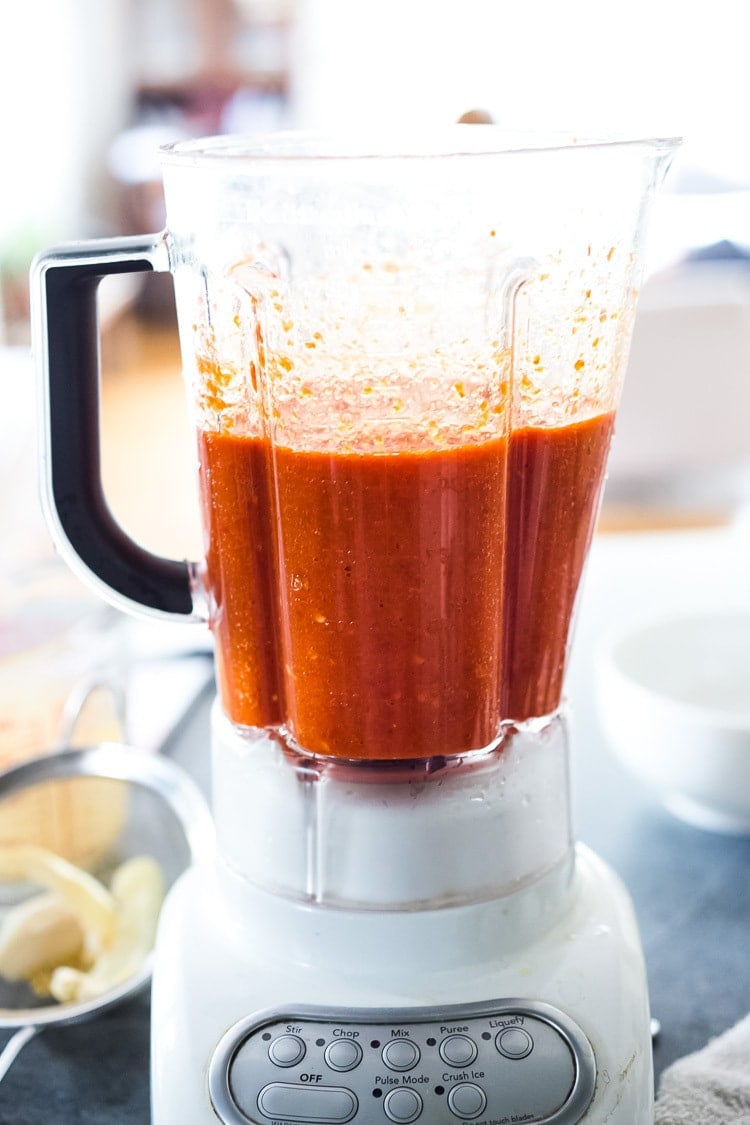
Step 8: Store! For everyday use, store the fermented hot sauce in squeeze bottles– leaving the tip off or open (or lightly closed) in the fridge. The hot sauce will continue to ferment in the fridge, and the open tip will allow the gasses out. Before using, cover the tip with your finger and give it a good shake.
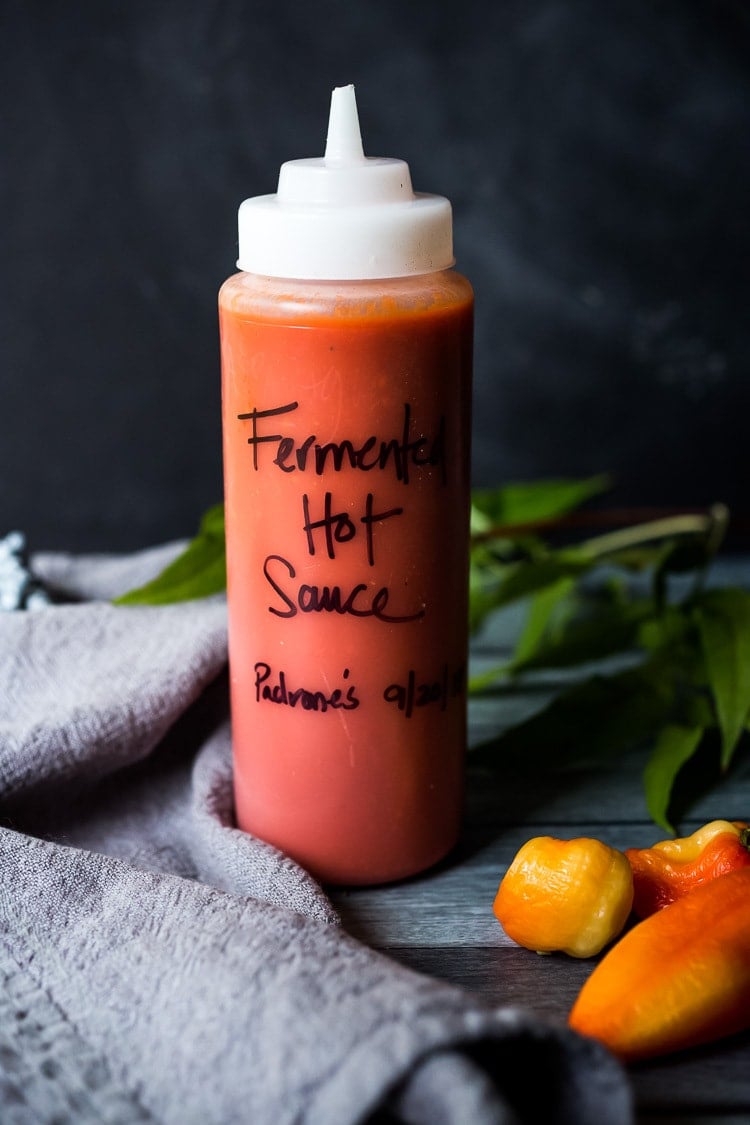
A little Warning!
If you place the fermented hot sauce in tightly sealed bottles, unrefrigerated, they will EXPLODE! This is because the hot sauce is still fermenting (producing gases) and will continue to create bubbles. Remember, it is alive, and this is NOT canning.
*If giving as a gift, yes, feel free to use a “cute bottle” but with instructions to refrigerate and loosen the lid.
But my hot sauce is way too hot!
Don’t be too alarmed if your hot sauce tastes overly hot when you first store it. After a week or two in the fridge, the gradual slow fermenting will substantially mellow out the heat! It’s quite surprising. Many times, I’ve made a hot sauce and tried it, thinking there was no way we would be able to eat it because of the heat level. But after a week or two, it really does calm down the heat. Fermenting the hot sauce gives it another layer of flavor, adding more and more complexity. This will keep indefinitely in the fridge.
Types of chilies to use:
Use any fresh chili pepper you like or a blend of different peppers (in the same color palate). To temper the heat, feel free to add similarly colored bell peppers (red, yellow, or green bell pepper). For example- add a golden bell pepper to habaneros to temper the heat. Or a green bellpeper to serano chilies.
Keep in mind you will be blending the sauce, so stick with the same color palate to make a vibrant-colored sauce. For example, mixing red and green peppers will yield a brown hot sauce- not the prettiest, but up to you. 😉
Also, keep in mind that fermentation will mellow out the heat of the peppers over time.
I am hearing that frozen peppers can be fermented ( please read the comments), but have not personally tried this.
Helpful tools
- Fermentation Kit (optional)
- Fermentation weights
- 2-quart mason jar (8-cup mason jar)
- Blender
- Strainer
- squeeze bottles
Making Fermented Hot sauce is a fun little project that only takes about 20 minutes of hands-on time. A lovely way to use up all the chilis in your garden (or a way to try out all the beautiful varieties at the farmers market) and a healthy way to bring more healthy probiotics into your life!
Mother Nature will do all the work for you! And after 5-7 days, you will end up with the most delicious, alive hot sauce that will get better and better with age!
Troubleshooting
- If there are no signs of fermentation, double-check you measured the salt ratio correctly. This is typically the most common problem (adding too much salt will halt the process and kill all the bacteria, even the good ones.).
- Try filtered water. Chlorinated water can halt fermentation.
- Do not over-wash or peel the peppers/carrots (for example, don’t use any type of produce soap) as the wild bacteria from the pepper skin, carrot peeling is what is starting the fermentation. I have the best luck with farmers’ market chili peppers and carrots because they are not over-cleaned or treated with anything.
- Mold: If your ferment has molded, something likely rose to the top of the jar and had contact with air. I would start over.
- Bad smell: the brine should smell tangy, garlic, and fresh, not “foul” in any way! If it smells “off,” it could be that salt was mismeasured or the ferment was contaminated: dirty hands, dirty utensils, dirty jar.
More Favorite Recipes!
- Yum Yum Sauce
- How to Make Kimchi!
- Simple Cabbage Sauerkraut
- Beet and Cabbage Sauerkraut
- Probiotic Gut Shot
- Curtido & Cultured Salvadoran Slaw
- How to make Fermented Pickles!
More from Feasting At Home
Watch HoW to make Fermented Hot Sauce!
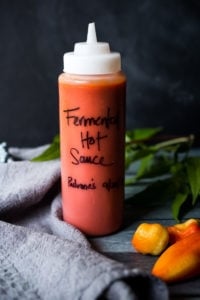
Fermented Hot Sauce
- Prep Time: 20 minutes
- Cook Time: 5 days
- Total Time: 120 hours 20 minutes
- Yield: 4 cups
- Category: Sauces, fermenting, preserving
- Method: fermenting
- Cuisine: American
- Diet: Vegan
Description
A simple, delicious recipe for Fermented Hot Sauce using fresh summer chilies, with no special equipment and only 20 minutes of hands-on time!
Ingredients
Saltwater Brine: ( 1 1/4 teaspoon salt per 1 cup of warm water) This is roughly a 3% Brine. (3 grams of salt per 100g of water)
- 5 cups filtered water
- 6 1/4 teaspoons finely ground sea salt (or Pink Himalayan salt) – use 1 1/4 teaspoon salt, per 1 cup of water.
- 2 Quart Mason Jar
Fillings:
- 16 ounces fresh chili peppers, sliced in half (about 6-7 cups) seeds & stem removed, see notes
- 1 carrot, very thinly sliced 1/16th-inch (do not peel!)
- 4–8 garlic cloves, cut into quarters
- 1–2 shallots, sliced (or 1/2 an onion)
After fermenting, add optional seasonings to taste. Keep in mind the “heat” will mellow with age.
- optional: herbs (oregano, cilantro, celery leaves) and spices (cumin, coriander, chipotle powder, smoked paprika)
- 1–3 tablespoons apple cider vinegar, (optional- for extra tang and for more healthy probiotics)
- honey or sugar to taste (optional, good if making Sriracha style)
- If your hot sauce is not hot enough, you can always add cayenne or ground chipotle to taste. Free free to add spices ( 1/2- 1 teaspoon) cumin, coriander, chipotle, allspice, etc. Make this your own.
Instructions
- Wash your hands, jar and ustensils. Not sterilized, just clean. 🙂
- Stir sea salt into the water until dissolved.
- Slice the small hot peppers in half, and remove stems and seeds if you like (for less heat). If your pepper are very hot, wear gloves. If adding bell peppers to temper the heat, cut into thin strips. Thinly slice the carrot (do not peel), slice the shallots, and slice the garlic.
- Layer all into a clean 2-quart mason jar. Top with a cabbage leaf to hold things down (optional) and pour the brine into the jar over the chilies, pressing them down under the liquid. If you need to add more brine, remember to use the ratio of 1 1/4 teaspoon salt per 1 cup of water.
- Weigh everything down with a fermentation weight (or use a small ziplock bag filled with water to weigh the veggies down or try a clean shot glass). You want the chilies completely submerged under the brine. Anything that touches air, may mold, so either spoon it out or push it down. Cover loosely with a lid ( or cheesecloth and rubber band) and place the jar in a pan or bowl to collect any liquid that may bubble over. The lid is loose here so gasses can escape easily, but no creatures can get in.)
- Place in a cool dark place, like the basement, 65-70F is ideal, (or the bottom cupboard in the kitchen) for 5-10 days or until signs of fermentation.
- On day 3-5: Check for fermentation: Tap the container and see if any tiny bubbles rise to the surface, check for a cloudy brine ( see notes) or check the bowl underneath, to see if there was any overflow. All signs of activity! Ferment 7-10 days, long enough to soften those carrots that you will be blending. And you can always ferment longer for even more flavor- I’ll often ferment 12 -14 days. Sometimes I’ll ferment 7 days, then place the jar in the fridge for a few weeks before blending. The longer the ferment, the tangier and more flavorful this will become, and the more mellow the heat. *If there are no signs of fermentation, give it a couple more days- then check the troubleshooting section in the post.
- After 7 days and signs of fermentation, strain and SAVE the brine. Place the fermented peppers, onions, garlic, and carrots into a blender and discard the cabbage leaf. Add 1 cup of the brine and blend until smooth as possible. This may take a couple of minutes. Add the vinegar if using, (and honey if you prefer a sweeter hot sauce like Sriracha), and more brine to desired thickness. At this point, you can blend in optional spices and herbs. ( 1/2-1 teaspoon spices, 1-2 tablespoons fresh herbs).
- Don’t be alarmed if it is overly spicy- the heat level will significantly mellow with time, as it continues to ferment in the fridge after 1-2 weeks. Place in a squeeze bottle and store in the fridge, leaving the tip open (or loose) for gasses to escape.
- Do not place in a sealed jar unrefrigerated– this will result in an explosion– and a great big mess- as the hot sauce is still alive and fermenting! BE WARNED! I have the best luck with using in squeeze bottles and leaving the cap off in the fridge.
- If transporting to a friend as a gift, it is ok to seal for short periods of time (a few hours) but make sure to tell them to refrigerate it and loosen the lid, very soon after receiving.
- The flavors will continue to develop and get more complex over time, the heat mellowing.
- To use, cover the tip of the opening with your finger and give a shake before using.
- This will keep up to 12 months in the fridge (probably even longer!).
Notes
WATER: Regular tap water may contain too much chlorine in it, inhibiting the fermentation process (although our tap water works fine). If fermentation is not happening, you may want to try filtered water.
SALT: I use fine ground sea salt or Pink Himalayan salt . If using coarse ground salt you may need to add a pinch more.
Peppers: Use any chili pepper you like or a blend of different peppers (in the same color palate). To temper, the heat, feel free to add similar colored bell pepper -substitute sweet red, yellow, or green bell pepper. Keep in mind, you will be blending the sauce, so stick with the same color scheme to make a vibrant colored sauce. For example, mixing red and green peppers will result in a brown hot sauce– but up to you. 😉 Also, keep in mind, the fermentation will mellow the heat a little. Removing the seeds will help temper the heat.
RATIO: If you need more water to cover or fill the jar, use 1 1/4 teaspoon salt per cup of warm water.
You could easily halve this recipe or use two, quart-sized jars.
CLOUDY BRINE: A cloudy brine is a natural by-product of the fermentation process-a combination of lactic acid and yeast and is the reason why they call it Lacto-fermentation. It is a sign of fermentation. Various strains of bacteria are present on the surface of all plants, especially ones growing close to the ground. Lactobacillus bacteria convert sugar into lactic acid, preserving the peppers.Lactic acid prevents the growth of harmful bacteria. Over time the cloudiness can settle out of the brine to the bottom of the jar. Some batches are naturally cloudier than others, but all are safe to consume and taste delicious. A cloudy brine is a sign that you have a safe and successful ferment.
Signs of fermentation: liquid overflowing into the bowl (check the bowl to see if the jar overflowed, a good sign! Tiny bubbles rising to the top when you tap the jar. Cloudy brine, tangy flavor or smell.
Nutrition
- Serving Size: 1 tablespoon
- Calories: 4
- Sugar: 0.4 g
- Sodium: 112.3 mg
- Fat: 0 g
- Saturated Fat: 0 g
- Carbohydrates: 0.9 g
- Fiber: 0.2 g
- Protein: 0.1 g
- Cholesterol: 0 mg
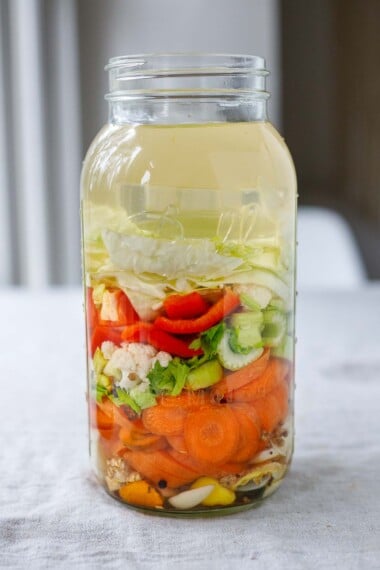
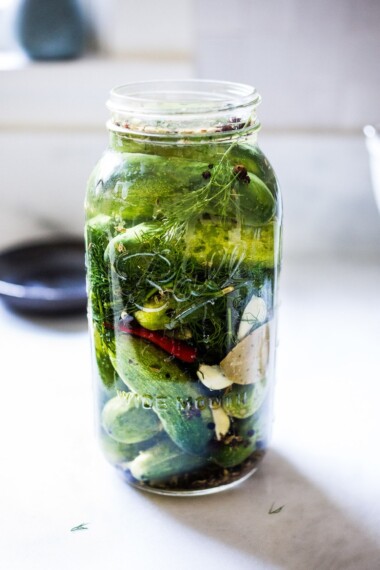
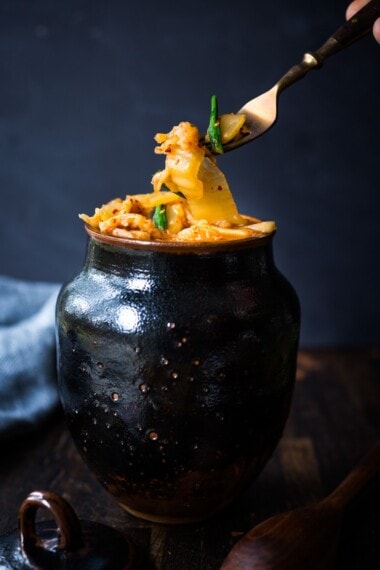
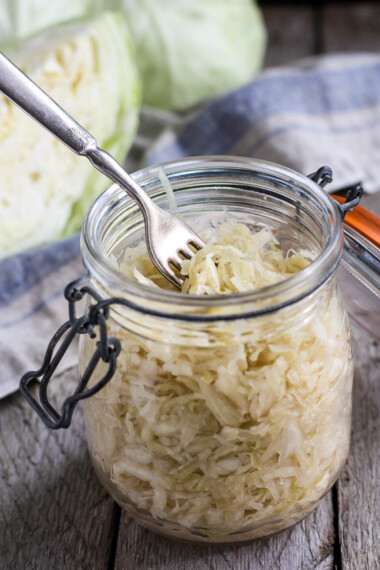


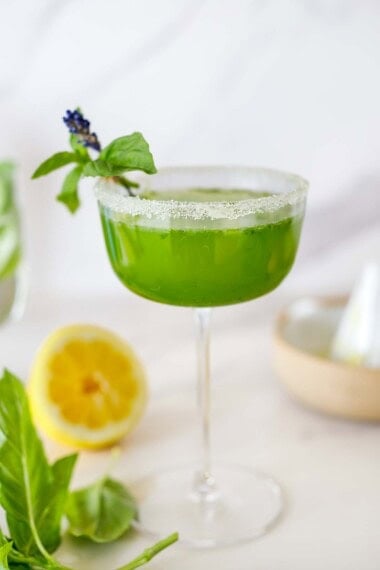
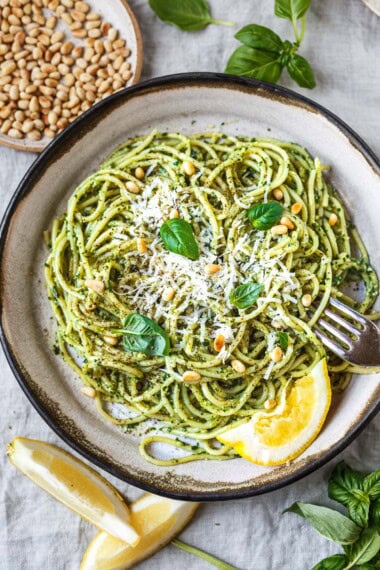

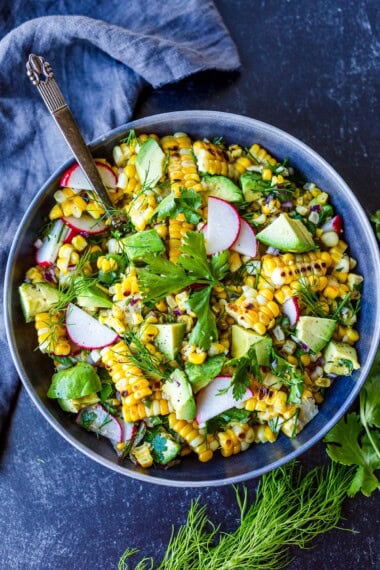
loved the way you gave the information amount it is easy to understand thenks
thanks!
Hi!! Making this today… at what point do you add the herbs? I’m thinking when you blend it and not during the fermenting stage?? But wanted to make sure! 🙂 Thanks!
You can do either!
Hi!
How do I close the jar, if there’s a ziplock weighting it down?
Just empty some of the liquid out and push the little ziplock down inside the jar. I have to fiddle with the amount of water in the ziplock as well. You can actually use anything to weigh the chilies down under the brine…just make sure it’s clean. 🙂
Hi Sylvia, it has been a week and I still have no bubbles… I am assuming fermentation is not happening. Do you think I should leave it for longer? Or do you think it’s safe to eat anyway? I did make a pretty large jar.
Is the liquid cloudy? Are there little bubbles when you tap on the jar?
I made thia a couple of years back and had the same problem: lack of fermentation. I checked out a couple of other recipies and saw one that suggested adding the liquid that is in yogurt before you stir it to help with the fermentation. I did this and it helped kick start the fermentation process.
Another thing I did was rather than putting all the ingredients in a blender I put them through a passouir that seperated the solids (pips, stems etc) from the juices. I bottled the liquid and kept it in the fridge (very yummy) and the left over solids were put on a baking tray and put in a low heates oven for at least 5 hours. Once this was dried out I then blended it into a fine powder. It makes an excellent chilli powder.
I’m hoping 5 stars!
Ooooops I added vinegar to jars at the start.
This will stop fermentation, I think?
Please help, I picked about 80 of my best assorted chillies!
It might stop it, how much did you add?
Could you add blueberries after fermentation in blender? Would I need to cook after blending in blueberries for shelflife?
Great question and I dont know. If you cook it will kill all the great probiotics. What if you ferment them with the chilies?
Can I ? Put them in with the ferment? Thanks
I think so? I guess that would try? Or blend after if you like.
Thanks for the recipe. Currently testing longevity. I added cane vinegar for that kick.
Wow I am happy to find this recipe because I will have a huge chili harvest this year and was thinking what do to with them, apart from the fact that I like to freeze fresh green chilis which I need for my Indian curries.
Your recipe sounds great and I will follow it and after share my experience. Thank you.
Perfect! You will love it!
So..and am about to rock this with a small modification of hickory smoked sea salt and a couple of others… but many people say to stir it once a day is your suggestion not to touch it at all for at least 5 to 7 days
Yes I am taking pictures and doing this for an article and I will make sure that I tagged back on where I got the inspiration from
That sounds interesting and yummy! Let me know how it turns out. Yes, I’ve seen the stirring recommendations, but I never have and have made it many times now…but please, do as you think!
I am about to blend my sauces… I really like this recipe & I’m interested in how you use the leftover brine?
I was given some plum coloured ghost like chilli’s… super heart starting, so I’ve done a couple of these batches, slightly different to see how they go… to be honest, I’m a little scared of these chilli’s… but I love fermented hot sauce more!
I would use the hot peppers sparingly. Incorporate with other milder chilies?
You can use the brine as a flavor booster for soups and stews, if you like- it keeps forever!
WOW, great recipe, thank you! Been looking for ways to make tomato sauce without sugar, didnt even think of fermenting, what an idiot lol
Awesome, let me know what you think!
Question: I have been freezing my Carolina Reaper peppers because they are too hot for me to grill and eat with steak. Will previously frozen peppers work for fermenting?
So someone else just tried this, see comments above. I guess adding the other fresh ingredients will start the ferment.
Hi, Great recipe. Would you advise a certain amount of brine per weight/volume of peppers etc. or is it always enough to submerge the contents of the jar?
Thanks.
Enough to submerge. 🙂
I froze my peppers last fall. Do you think I can use them?
That is a great question Ralph…and I’m not sure. My guess is you need the bacteria from fresh peppers to start the fermentation and freezing them kills those bacteria. But I’m not an expert in this area.
Followed recipe with frozen habanero varietal. 2 days into fermentation and we have vigorous bubbling. You would likely still get fermentation if using other fresh veg/tubers. Reason being that they will bring their own microbe communities.
I had about 10 fat peppers thawed, 2 medium carrots, 1 orange bell pepper and 6 cloves garlic. Smells delicious
Thanks so much- glad you liked!
I am a SRILANKA CHEF 35 YEARS EXPERIENCE IN THIS FIELD. SAME THIS WE MAKE PICKEL BUT NOT BLENDER I HOPE I CAN MAKE HOT SAUCE FROM YOUR METHOD.THANKS LOT.
For canning, you must achieve a pH of less than 4.6 to be shelf-stable (safe.) This can be achieved by adding vinegar, citric acid, or citrus juice (orange, lime, lemon, etc.) but you need to test it before canning. I like a pH near 4.0, well withing the safe range. I’ve seen recipes that suggest pH levels of 3.4- more than 10x more acidic than necessary. I’ve made delicious sauces with pH in the mid 3’s and they were more tart than I like, but still delicious. Research the “Hot Fill/Hold” method of bottling hot sauce. Sterilize bottles before filling and never re-use a bottle cap. Good luck.
Could I do this with dried peppers and get a viable sauce? I’m new to making hot sauce and fresh peppers are currently out of season. I do have a load of dry peppers though!
Hi Zoey, Im not sure dried pepper would ferment? That being said,I don’t know for sure. Maybe once they are reconstituted. Let me do some research and get back to you. I might have to try this because I have a lot of dried peppers too!
I have fermented dried peppers and they come out okay. They ferment fine, but they didn’t seem to reconstitute 100% so there were still some hard pieces in the final product. I would do fresh if you can, and use dried as a last resort.
Thanks for sharing, appreciate this!
Hi! The downside to dried peppers is that they lack the bacteria needed for fermenting. Simply add the water from store bought RAW or LIVE saurkraut to a salt water brine and continue the recipe. I added a half cup of the kraut water to a quart jar and filled the rest of the jar with the brine. Smells amazing.
Thanks! I’m going to try it. Just an FYI… you can certainly can it, but the heat will kill the microbes. Fermentation doesn’t preserve things forever, but it still does a pretty good job, especially if you refrigerate it once it’s reached the point where you’re happy with the flavor.
Hello! How long will your sauce keep? I fermented three 10 liter crocks two years ago. My crocks each had different pepper mixes; all had the same garlic and salt brine. I did not add carrots or onion to them, FYI. I let each crock ferment for three months. After that, I did as you recommend here – reserve the brine, blend the peppers and garlic, adding back brine to achieve the desired consistency. I did not add vinegar or sugar to the end result. I did not keep the blend on the counter for a week or more as some suggest – my (hot sauce) bottles went directly into the refrigerator after filling. I did keep the remaining brine for use in beans, soups, etc. Two years later, I have one last bottle of hot sauce left, with only a couple ounces left in the bottle. The hot sauces saved marvelously all this time, without adding vinegar (or sugar), before bottling. Of course one should always continue to check for signs of the sauce going south, but from three varying batches, all three were wonderful for that two year storage (and daily use) in the fridge.
Josh, you asked about a vinegar taste . . . I, too, hate the taste of tabasco! Two years ago, I also made a non-fermented hot sauce blend that included the carrots and onions. This was a sauce I cooked down, then canned, and vinegar was added (it was the only reason I did not ferment with carrots and onions . . . can’t wait to try Sylvia’s fermented recipe next fall). I will tell you that the non-fermented hot sauce with added vinegar did not taste like it had vinegar, however, my fermented sauces that did not have vinegar, actually kinda tasted like they did! It was not a tabasco tart; like Sylvia says, it was much deeper, more complex flavors that give a bite similar to vinegar. My point here is, blend your sauce and do not add vinegar or sugar to the end result. If you do not like it, then you can make additions afterward. I believe my much longer fermenting time in the crock lent to the depth/ complexity before it got to continue in the fridge – not good, not bad, just different. You might find that you prefer a lesser fermentation time versus a longer one. Perhaps you should experiment with fermentation time, before adding to the final product?
Thank you Sylvia for your great recipe . . . again, can’t wait to try it soon! .
Hi Leesa, thanks so much for sharing this. My hot sauce so far has kept for 5 months in the fridge and is still going strong. The vinegar is purely for flavor, and also because this is a short fermentation, this version is not as tangy as a longer ferment. The longer the ferment, the tangier.
Does this hot sauce end up tasting very vinegary? I’m interested in trying it out, but really do not enjoy vinegary hot sauces (i.e. Tabasco). Thanks!
Hi Josh, it is not at all vinegary! And you can add less vinegar if you like, just add it to taste. I like a little acidity, but I’m like you, do not want too much!
SALT!
I’m confused on the proportions.
1 teaspoon per cup water.
5 cups water.
There are 3 teaspoons per tablespoon, so….
1 tsp/cup x 5 cups x 1Tb/3 tsp = 1 Tablespoon + 2 teaspoons.
Hi Scott! Im so sorry…. this WAS so confusing! I fixed all the errors and think it is clearer now. USE 1 teaspoon SEA salt per cup of water. If using kosher salt, you could go up to 1.5 teaspoons per cup of water.
So, I just put all my lovely peppers & veggies in their brine to ferment and realized that I will be away at the 5-7 day mark.. Is it ok to let it go a day, or 2 longer?
Absolutely! just make sure peppers are submerged under the brine and lid isn’t very tight so air bubbles can escape.
I’ve fermenter mine for over 13 months now. Will be great.
What other chilis can I use in this.. I dont have Padrones. I do like spicy!
Hi Robin! Use any chilies you like. You can use a combination of different kinds if you like. 🙂
I love fermenting veggies but I have never tried making my own hot sauce. I am off the the farmer’s market to find some interesting peppers!
Yay! It is so much fun!
Thank you so much for this! I have a ton of chilis I need to use and this will be perfect! You always have the best recipes 🙂